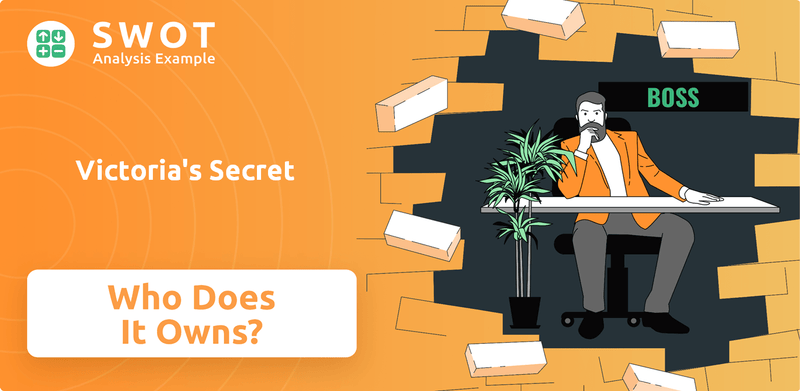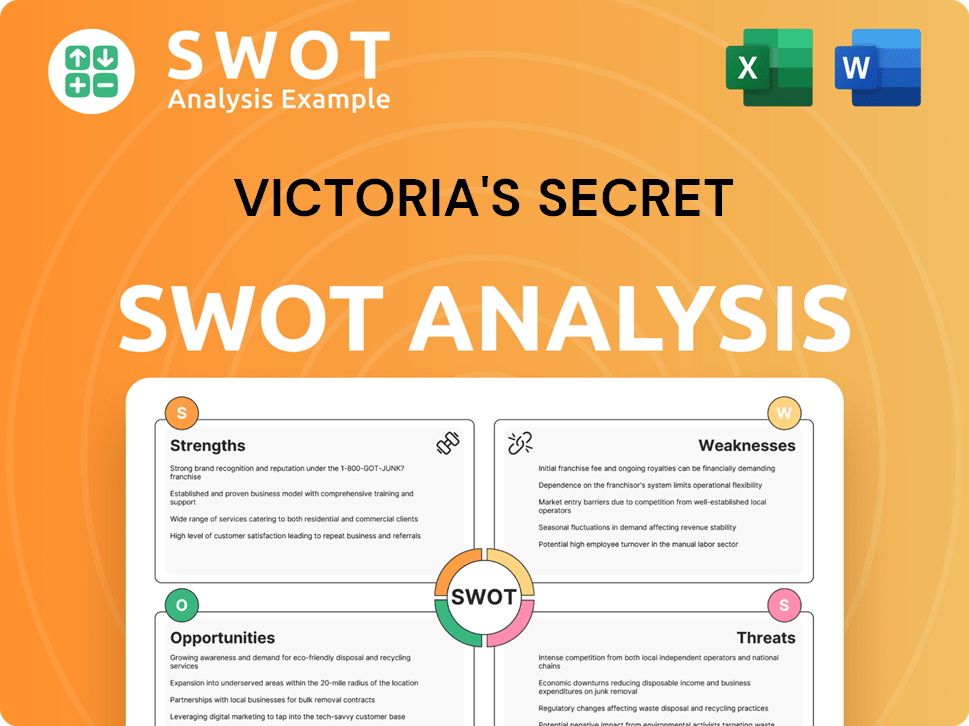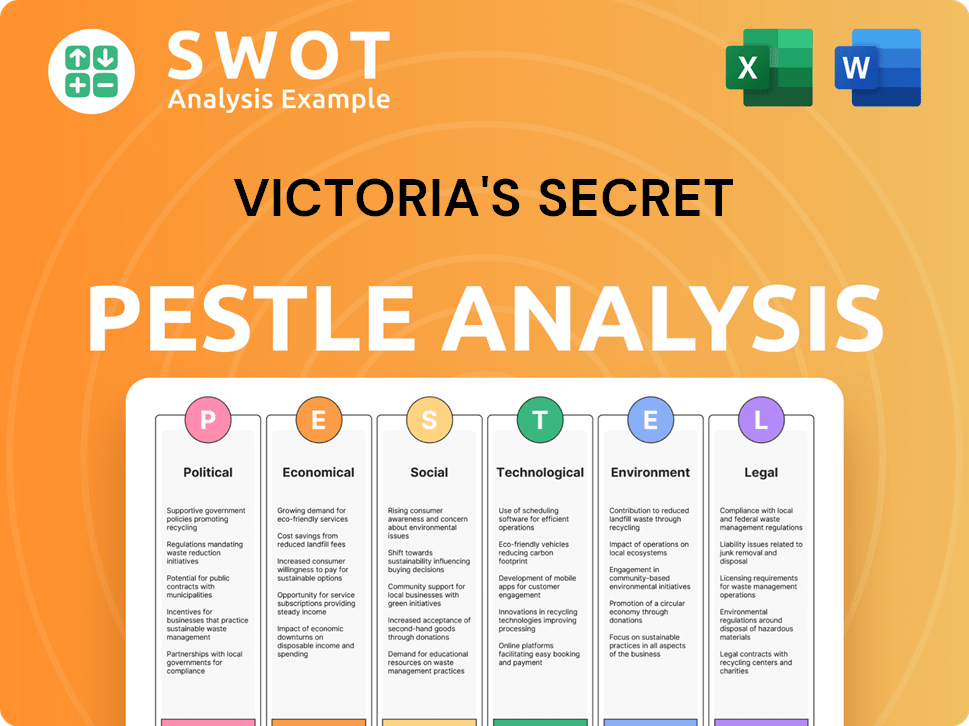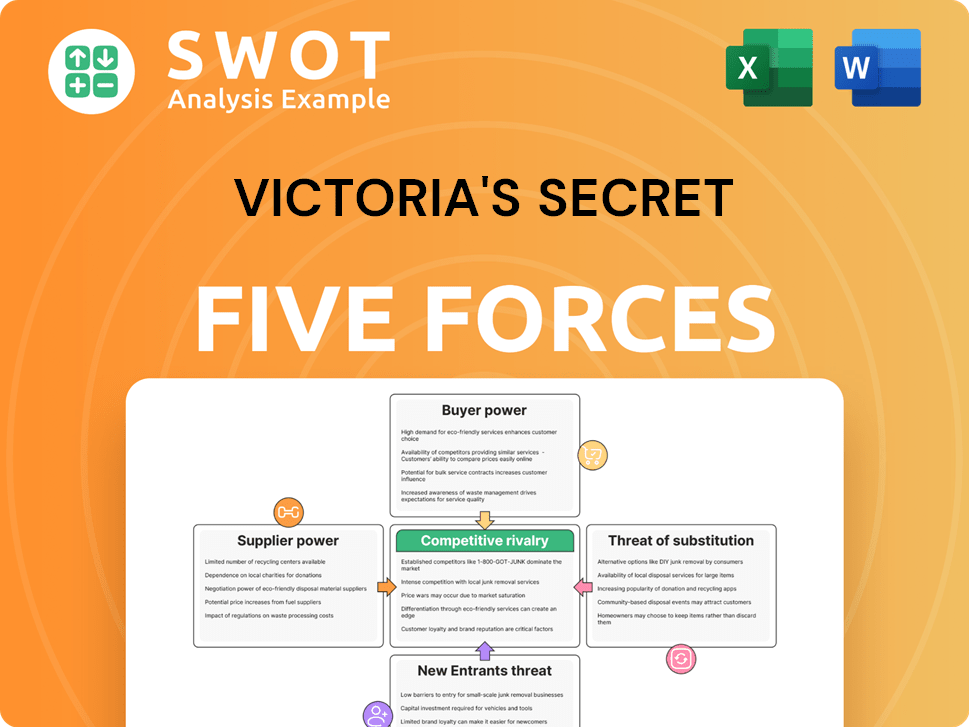Victoria's Secret Bundle
Who Really Owns Victoria's Secret?
Uncover the intricate web of Victoria's Secret SWOT Analysis and its ownership, a key factor in understanding its strategic direction and market positioning. From its inception in 1977 to its spin-off from L Brands (now Bath & Body Works, Inc.) in August 2021, the company's ownership structure has undergone significant transformations. This article provides a comprehensive look at the current owner of Victoria's Secret, its major stakeholders, and the evolution of its corporate identity.

Understanding the current owner of Victoria's Secret is crucial for investors and business strategists alike. The separation from L Brands marked a new chapter, transforming the company into an independent entity. This article explores the impact of this shift, examining the company's financial performance and the influence of its board of directors, providing valuable insights into the future of this iconic brand. Learn about Victoria's Secret's company structure and how it operates in today's market.
Who Founded Victoria's Secret?
The story of Victoria's Secret begins with its founders, Roy and Gaye Raymond, who launched the brand on June 12, 1977. Roy Raymond, a Stanford MBA graduate, created the concept after an uncomfortable shopping experience. The initial vision was to establish a retail environment where men would feel comfortable buying lingerie.
To get Victoria's Secret off the ground, Roy Raymond secured a total of $80,000. Half of this came from a bank loan, and the other half was provided by his family. The first store opened in the Stanford Shopping Center in Palo Alto, California. In its first year, the company generated $500,000 in sales.
The Raymonds were the primary owners in the early years. They were the sole founders and primary investors in the business. The early success led to the opening of additional stores and the introduction of a mail-order catalog, expanding the brand's reach and sales.
Roy Raymond founded Victoria's Secret in 1977 with his wife, Gaye Raymond. The first store opened in Palo Alto, California, with an initial investment of $80,000.
The initial funding came from a bank loan and family investments. The first year's sales reached $500,000, indicating early success.
Roy and Gaye Raymond were the initial owners. They were the sole founders and primary investors in the business.
By 1982, Victoria's Secret had expanded to five stores and a 40-page catalog. The company's annual gross sales reached $6 million.
In 1982, Roy Raymond sold Victoria's Secret to Leslie Wexner of Limited Stores Inc. for $1 million. Raymond remained as president for about a year.
Roy Raymond left Victoria's Secret in 1983 due to creative differences with Wexner. There is no public information detailing specific equity splits or early agreements.
By 1982, Victoria's Secret had grown to five stores and a 40-page catalog, generating $6 million annually. That same year, Roy Raymond sold the company to Leslie Wexner, the founder of Limited Stores Inc., for $1 million. The Brief History of Victoria's Secret details how Raymond stayed on as president for about a year before departing in 1983 due to creative differences. There is no public information available regarding specific equity splits or early agreements, such as vesting schedules or buy-sell clauses, for the Raymonds or any other early investors.
The initial ownership of Victoria's Secret was held by Roy and Gaye Raymond.
- Roy Raymond, a Stanford MBA, founded the company in 1977.
- The initial investment was $80,000, with sales reaching $500,000 in the first year.
- By 1982, the company was sold to Leslie Wexner for $1 million.
- Roy Raymond left the company in 1983.
Victoria's Secret SWOT Analysis
- Complete SWOT Breakdown
- Fully Customizable
- Editable in Excel & Word
- Professional Formatting
- Investor-Ready Format

How Has Victoria's Secret’s Ownership Changed Over Time?
The evolution of Victoria's Secret owner began in 1982 when Les Wexner's The Limited (later L Brands) acquired the company for $1 million. Wexner transformed the brand, focusing on appealing to female customers. By the early 1990s, the company had expanded to 350 stores nationwide, achieving $1 billion in sales and becoming the largest lingerie retailer in the United States. This early period set the stage for its significant growth.
In 2002, Intimate Brands, Victoria's Secret's parent company, merged with The Limited, which was later renamed Limited Brands. By 2006, Victoria's Secret and Bath & Body Works were the primary revenue generators for Limited Brands. The most recent major shift occurred on August 3, 2021, when L Brands spun off Victoria's Secret to become an independent public company, Victoria's Secret & Co. (NYSE: VSCO), marking a pivotal change in its ownership structure.
| Key Event | Date | Impact on Ownership |
|---|---|---|
| Acquisition by The Limited | 1982 | Les Wexner's control and expansion. |
| Intimate Brands merger with The Limited | 2002 | Consolidation under Limited Brands. |
| Spin-off from L Brands | August 3, 2021 | Became an independent public company, Victoria's Secret & Co. |
As of June 2025, Victoria's Secret & Co. has a market capitalization of approximately $1.45 billion USD. The ownership structure is largely held by institutional investors, who own about 79.63% of the stock. Insiders hold roughly 14.50%, while public companies and individual investors own approximately 5.87%. Major institutional shareholders include BlackRock, Inc., Vanguard Group Inc, iShares Core S&P Small-Cap ETF, and State Street Corp. Furthermore, as of March 2025, BBRC International Pte Limited, controlled by Brett Blundy, held approximately 13% of the outstanding shares, making it the second-largest shareholder. This prompted Victoria's Secret to adopt a shareholder rights plan in May 2025.
The ownership of Victoria's Secret ownership has evolved significantly, from its acquisition by The Limited to its current status as a publicly traded company. The majority of the company is now held by institutional investors.
- Institutional investors hold approximately 79.63% of the stock.
- Insiders own about 14.50% of the stock.
- BBRC International Pte Limited is a significant shareholder.
- For more information on the company's financial aspects, check out Revenue Streams & Business Model of Victoria's Secret.
Victoria's Secret PESTLE Analysis
- Covers All 6 PESTLE Categories
- No Research Needed – Save Hours of Work
- Built by Experts, Trusted by Consultants
- Instant Download, Ready to Use
- 100% Editable, Fully Customizable

Who Sits on Victoria's Secret’s Board?
As of August 2024, the leadership of Victoria's Secret & Co. saw a significant change. Hillary Super was appointed Chief Executive Officer and a board member, effective September 9, 2024, succeeding Martin Waters. Waters remained as an advisor until August 31, 2024, to assist with the transition. During the interim period in August 2024, Timothy (TJ) Johnson, the Chief Financial and Administrative Officer, served as the interim CEO. Further changes were announced in January 2025, with Timothy (TJ) Johnson set to retire in June 2025, and Scott Sekella appointed as the new Chief Financial Officer.
The specific composition of the board beyond the CEO is not detailed in the provided information. Generally, boards of directors include representatives from major shareholders, founders, and independent members. The current board members and their affiliations are not explicitly listed in the search results. For more information about the target market of the company, you can check out the Target Market of Victoria's Secret.
The voting structure at Victoria's Secret & Co. typically follows a one-share, one-vote system, common for publicly traded companies. However, to protect shareholder interests, a limited-duration shareholder rights plan was adopted in May 2025.
- This plan was enacted in response to BBRC International Pte Limited's accumulation of approximately 13% of outstanding shares.
- If any entity or group acquires a 15% stake (or 20% for passive investors), existing rights holders, excluding the triggering party, can purchase shares at a 50% discount.
- Alternatively, rights holders can exchange each right for one share of common stock.
Victoria's Secret Business Model Canvas
- Complete 9-Block Business Model Canvas
- Effortlessly Communicate Your Business Strategy
- Investor-Ready BMC Format
- 100% Editable and Customizable
- Clear and Structured Layout

What Recent Changes Have Shaped Victoria's Secret’s Ownership Landscape?
Over the past few years, significant changes have occurred in the ownership and leadership of Victoria's Secret & Co. The company, which spun off from L Brands (now Bath & Body Works, Inc.) on August 3, 2021, is now an independent, publicly traded entity (NYSE: VSCO). This separation marked a pivotal moment for the brand, setting the stage for its repositioning in the market. The shift in ownership structure has also brought about changes in the company's strategic direction and financial performance.
In terms of leadership, Hillary Super was appointed CEO and a board member on September 9, 2024, succeeding Martin Waters. Executive leadership changes were also implemented to streamline the team, including the elimination of Brand President and Chief Customer Officer roles in September 2024. Anne Stephenson became President of Victoria's Secret on May 12, 2025, Ali Dillion became President of PINK on the same day, and Amy Kocourek assumed the role of President of Beauty in March 2025. These changes reflect the company's efforts to adapt to market demands and enhance operational efficiency.
| Key Developments | Details | Date |
|---|---|---|
| Spin-off from L Brands | Became an independent publicly traded company (NYSE: VSCO) | August 3, 2021 |
| CEO Appointment | Hillary Super appointed CEO | September 9, 2024 |
| Shareholder Rights Plan | Implemented to protect shareholder value | May 2025 |
| Share Buyback Program | Board approved a new program authorizing the repurchase of up to $250 million of common stock | March 2024 |
Regarding ownership, institutional investors hold a substantial portion of VSCO stock, approximately 79.63%. A notable trend is the increasing stake held by BBRC International Pte Limited, controlled by Australian billionaire Brett Blundy, which reached around 13% by March 2025. To safeguard shareholder value, Victoria's Secret adopted a shareholder rights plan in May 2025, aiming to prevent any single entity from gaining control without a fair offer to all shareholders. The company has also been involved in share buyback programs, with the Board approving a new program in March 2024 to repurchase up to $250 million of common stock. For further insights into the company's strategic growth, you can explore the Growth Strategy of Victoria's Secret.
Victoria's Secret is a publicly traded company, with significant ownership by institutional investors. BBRC International Pte Limited, controlled by Brett Blundy, has also increased its stake.
Institutional investors hold a significant portion of VSCO stock, approximately 79.63%. BBRC International Pte Limited increased its holdings to approximately 13% by March 2025.
In March 2024, the Board approved a new program authorizing the repurchase of up to $250 million of common stock. As of March 21, 2025, no shares had been repurchased under this program.
The company's financial outlook for fiscal year 2024 was raised in December 2024, with net sales anticipated to grow by approximately 1% to 2%.
Victoria's Secret Porter's Five Forces Analysis
- Covers All 5 Competitive Forces in Detail
- Structured for Consultants, Students, and Founders
- 100% Editable in Microsoft Word & Excel
- Instant Digital Download – Use Immediately
- Compatible with Mac & PC – Fully Unlocked

Related Blogs
- What are Mission Vision & Core Values of Victoria's Secret Company?
- What is Competitive Landscape of Victoria's Secret Company?
- What is Growth Strategy and Future Prospects of Victoria's Secret Company?
- How Does Victoria's Secret Company Work?
- What is Sales and Marketing Strategy of Victoria's Secret Company?
- What is Brief History of Victoria's Secret Company?
- What is Customer Demographics and Target Market of Victoria's Secret Company?
Disclaimer
All information, articles, and product details provided on this website are for general informational and educational purposes only. We do not claim any ownership over, nor do we intend to infringe upon, any trademarks, copyrights, logos, brand names, or other intellectual property mentioned or depicted on this site. Such intellectual property remains the property of its respective owners, and any references here are made solely for identification or informational purposes, without implying any affiliation, endorsement, or partnership.
We make no representations or warranties, express or implied, regarding the accuracy, completeness, or suitability of any content or products presented. Nothing on this website should be construed as legal, tax, investment, financial, medical, or other professional advice. In addition, no part of this site—including articles or product references—constitutes a solicitation, recommendation, endorsement, advertisement, or offer to buy or sell any securities, franchises, or other financial instruments, particularly in jurisdictions where such activity would be unlawful.
All content is of a general nature and may not address the specific circumstances of any individual or entity. It is not a substitute for professional advice or services. Any actions you take based on the information provided here are strictly at your own risk. You accept full responsibility for any decisions or outcomes arising from your use of this website and agree to release us from any liability in connection with your use of, or reliance upon, the content or products found herein.